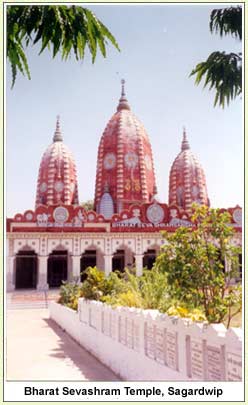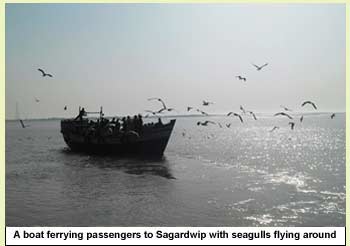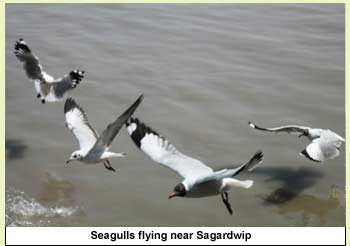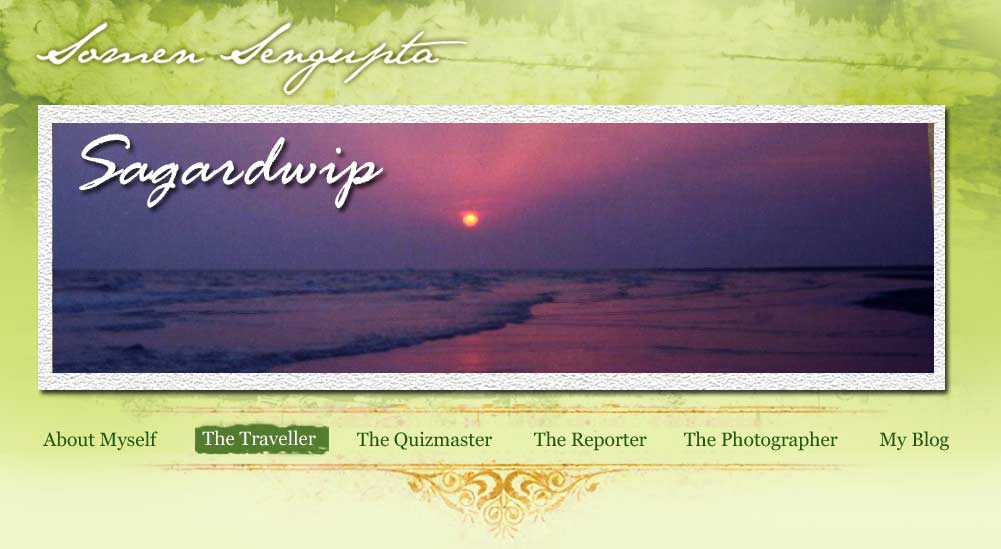| If the thought of another trip to the overcrowded beaches of Digha or Puri draws a grimace rather than a grin, it is time to tread off the beaten track. Acres of silver sand and clear blue sky is not as far away from home as you think. On an isolated island in south Bengal, barely 135 km from the city, a picture perfect beach awaits you.
 Sagardwip, popularly known as Gangasagar, is unexplored and hence unexploited. It is not just a place that pilgrims flock to for one of the largest religious congregations in this part of the country. The island, the largest in the Sunderbans, offers natural beauty in abundance. It is the ideal place to unwind after an exhausting week at office. Sagardwip finds a mention in many tales of Hindu mythology and in ancient Indian literature. The Ramayana talks of the island. In the Mahabharata, the Pandavas go for sagarsangam. Bankimchandra Chattopadhyay set a novel and Rabindranath Tagore a poem in Sagardwip. Sagardwip, popularly known as Gangasagar, is unexplored and hence unexploited. It is not just a place that pilgrims flock to for one of the largest religious congregations in this part of the country. The island, the largest in the Sunderbans, offers natural beauty in abundance. It is the ideal place to unwind after an exhausting week at office. Sagardwip finds a mention in many tales of Hindu mythology and in ancient Indian literature. The Ramayana talks of the island. In the Mahabharata, the Pandavas go for sagarsangam. Bankimchandra Chattopadhyay set a novel and Rabindranath Tagore a poem in Sagardwip.
A peek into the island’s past will make the trip more interesting. Myths, however, are indistinguishable from facts when one delves into Sagardwip’s history. Legend has it that Raja Sagar, a king of Ekshakshu dynasty, ruled the island from Ayodhya. He once planned an ashwamedh yagna. The sacred yagna horse was stopped by Indra. Sagar’s 60,000 sons started looking for the horse. The animal was finally found at Maharishi Kapil’s ashram. When the king’s sons accused the sage of stopping the horse, he reduced them to ashes.
Years later, the great grandson of the king, Bhagirath, managed to bring Ganga from Gomukh to Sagardwip, where the river merged with the Bay of Bengal. The confluence lifted the curse on the 60,000 sons of Sagar. The dynasty regained its former glory. Ever since, millions believe a pilgrimage to the island washes away their sins and ensures a passage to heaven. This is mythology. History has a different tale to tell. There was dense forest cover in Sagardwip till the early part of the 18th Century. There is no evidence that anyone lived on the island after 1688. In 1810, an employee of the British East India Company named Robertson first stumbled upon an assembly of thousand of Hindus at Sagarmela. But during those days, the place used to remain deserted at other times.
In 1822, East India Company sent five families from the Arakan valley to settle on the island. The project was a success. Population boomed at Sagardwip. But the human settlement was threatened by devastating tornadoes. The first was in 1833, followed by another in 1864. Nothing, however, halted the annual assembly in winter. Pilgrims used to come from as far off as Sri Lanka and Lahore. The island developed slowly. The first Durga puja was held in 1933. A meeting of the Congress party was also held on Sagardwip the same year. The first motorable road was constructed in 1960. The island was finally electrified in the 1990s.
Dawn and dusk are enchanting on the beach. There is hardly a soul, only red crabs play hide and seek on the sand. They dive into their holes as you approach. Rows of trees border the sea front. The sunset is spectacular. The sky turns golden with a patch of red on the horizon. The silver sand reflects the last rays of the sun to create a magical ambience. You might come across honeymoon couples savouring a memorable moment. Large cargo ships, oil tankers, fishermen’s boats and their blue nets complete the panorama.
The lighthouse on the island is significant. It guides vessels on their way to Calcutta. If you are looking for pilgrimage, head for the Kapil temple on the beach. This is the fourth Kapil temple constructed on the island. The first one, founded by Rani Satyabhama in 437, was razed by a tornado. The two temples after that were destroyed by the sea. In 1961, chief minister BC Roy visited the island and donated Rs 11,000 to construct the current temple, which was completed in 1973. The structure is simple and houses images of Kapil, Ganga, Bhagirath, Indra and Sagar. It is managed by Rajguru Ramchand of Hanuman Gadi in Ayodha. The Bharat Sevashram Sangha temple is bigger and has three massive towers. Prime Minister Morarji Desai had laid its foundation stone on May 28, 1979. You can also visit the Onkarnath temple and the Ramakrishna Mission.
 If you are not religiously inclined, play the beach bum. A day of sun, surf, sky and sand will be rewarding enough. If you are not religiously inclined, play the beach bum. A day of sun, surf, sky and sand will be rewarding enough.
Going
Sagardwip is just 135 km from the city. But there is no direct connectivity from Calcutta. A break journey is a must. Take a Kakdwip-bound bus from Esplanade to Harwood Point. The journey takes about three hours. Cross the river by boat to reach Kachuberia. Another hour by bus will take you to Gangasagar. Minibus and hired car are available for the journey. You should reach the island about five hours after leaving the city.
Staying
Budget accommodation is easily available in Sagardwip. Hotel Larica, Youth Hostel and Bharat Sevashram Sangha guest house are the best options. There are many smaller hotels. Unless you want to be there for Sagarmela, avoid the island in mid-January. There is electricity on the island from 6 pm to10 pm. Vessels from Harwood Point and Kachuberia are available every hour. There are plenty of eateries. There is no restriction on photography |



